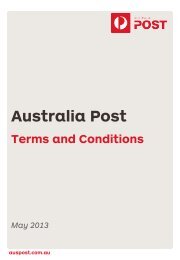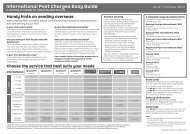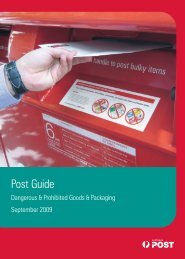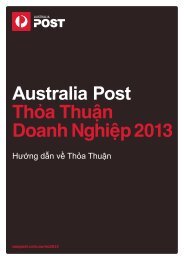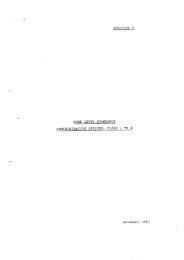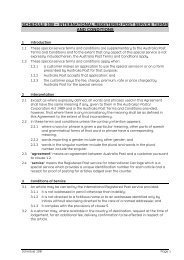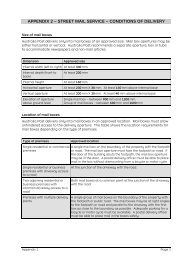2009-10 Annual Report - Australia Post
2009-10 Annual Report - Australia Post
2009-10 Annual Report - Australia Post
Create successful ePaper yourself
Turn your PDF publications into a flip-book with our unique Google optimized e-Paper software.
(iii) dividends<br />
revenue is recognised when the group’s right to receive the payment<br />
is established.<br />
(iv) rental income<br />
rental income from investment properties is accounted for on a<br />
straight-line basis over the lease term. contingent rental income<br />
is recognised as income in the periods in which it is earned. lease<br />
incentives granted are recognised as an integral part of the total<br />
rental income.<br />
(g) operating segment<br />
an operating segment is a component of an entity that engages in<br />
business activities from which it may earn revenues and incur expenses<br />
(including revenues and expenses relating to transactions with other<br />
components of the same entity), whose operating results are regularly<br />
reviewed by the entity’s chief operating decision maker to make<br />
decisions about resources to be allocated to the segment and assess<br />
its performance and for which discrete financial information is available.<br />
Management will also consider other factors in determining operating<br />
segments, such as the level of segment information presented to the<br />
board of directors.<br />
operating segments have been identified based on the information<br />
provided to the chief operating decision-makers – being the executive<br />
management team.<br />
operating segments that meet the quantitative criteria as prescribed<br />
by aasB 8 are reported separately. information about other business<br />
activities and operating segments that are below the quantitative<br />
criteria are combined and disclosed in a separate category as an<br />
“unallocated” segment.<br />
(h) Government grants<br />
Government grants are recognised when there is reasonable assurance<br />
that the grant will be received and all attaching conditions will be<br />
complied with. When the grant relates to an expense item, it is<br />
recognised as income over the periods necessary to match the grant<br />
on a systematic basis to the costs that it is intended to compensate.<br />
the grants are not credited directly to shareholders’ equity. When the<br />
grant relates to an asset, the fair value is credited to a deferred income<br />
account and is released to the statement of comprehensive income over<br />
the expected useful life of the relevant asset by equal annual instalments.<br />
(i) leases<br />
the determination of whether an arrangement is or contains a lease<br />
is based on the substance of the arrangement. it also requires an<br />
assessment of whether the fulfilment of the arrangement is dependent<br />
on the use of a specific asset or assets and the arrangement conveys<br />
a right to use the asset.<br />
(i) Group as a lessee<br />
Finance leases, which transfer to the group substantially all the risks<br />
and benefits incidental to ownership of the leased item, are capitalised<br />
at the inception of the lease at the fair value of the leased property<br />
or, if lower, at the present value of the minimum lease payments. lease<br />
payments are apportioned between the finance charges and reduction<br />
of the lease liability so as to achieve a constant rate of interest on the<br />
remaining balance of the liability. Finance charges are recognised as<br />
an expense in profit or loss.<br />
capitalised leased assets are depreciated over the shorter of the<br />
estimated useful life of the asset and the lease term if there is no<br />
reasonable certainty that the group will obtain ownership by the<br />
end of the lease term.<br />
operating lease payments are recognised as an expense in the<br />
statement of comprehensive income on a straight-line basis over<br />
the lease term. operating lease incentives are recognised as a liability<br />
when received and subsequently reduced by allocating lease payments<br />
between rental expenditure and reduction of the liability.<br />
(ii) Group as a lessor<br />
leases in which the group retains substantially all the risks and benefits<br />
of ownership of the leased asset are classified as operating leases.<br />
initial direct costs incurred in negotiating an operating lease are added<br />
to the carrying amount of the leased asset and recognised as an<br />
expense over the lease term on the same basis as rental income.<br />
(j) Cash and cash equivalents<br />
cash and cash equivalents in the balance sheet comprise cash at bank<br />
and in hand and short-term deposits with an original maturity of three<br />
months or less that are readily convertible to known amounts of cash<br />
and which are subject to an insignificant risk of changes in value. For the<br />
purposes of the cashflow statement, cash and cash equivalents consist<br />
of cash and cash equivalents as defined above, net of any outstanding<br />
bank overdrafts. Bank overdrafts are included within interest-bearing<br />
liabilities in current liabilities on the balance sheet.<br />
(k) trade and other receivables<br />
trade receivables, which generally have 30–90 day terms, are<br />
recognised initially at fair value and subsequently measured at<br />
amortised cost using the effective interest method, less an allowance<br />
for impairment. other receivables are initially recorded at the fair<br />
value of the amounts to be received and are subsequently measured<br />
at amortised cost.<br />
collectability of trade receivables is reviewed on an ongoing basis at an<br />
operating unit level. individual debts that are known to be uncollectible<br />
are written off when identified. an impairment provision is recognised<br />
when there is objective evidence that the group will not be able<br />
to collect the receivable. Financial difficulties of the debtor, default<br />
payments or outstanding debts more than 60 days overdue may<br />
be considered objective evidence of impairment. the amount of the<br />
impairment loss is the receivable carrying amount compared to the<br />
present value of estimated future cashflows, discounted at the original<br />
effective interest rate.<br />
(l) inventories<br />
inventories including raw materials, work in progress and finished<br />
goods are valued at the lower of cost and net realisable value. costs<br />
incurred in bringing each product to its present location and condition<br />
are accounted for as follows:<br />
• raw materials – purchase cost on a first-in, first-out basis. the cost<br />
of purchase comprises the purchase price, including the transfer from<br />
equity of gains and losses on qualifying cashflow hedges of purchases<br />
of raw materials, import duties and other taxes (other than those<br />
subsequently recoverable by the entity from the taxing authorities),<br />
transport, handling and other costs directly attributable to the<br />
acquisition or raw materials. Volume discounts and rebates are<br />
included in determining the cost of purchase; and<br />
• finished goods and work-in-progress – cost of direct materials and<br />
labour and a proportion of variable and fixed manufacturing overheads<br />
based on normal operating capacity. costs are assigned on the basis<br />
of weighted average costs.<br />
net realisable value is the estimated selling price in the ordinary course<br />
of business, less estimated costs of completion and the estimated costs<br />
necessary to make the sale.<br />
AustrAliA <strong>Post</strong> AnnuAl rePort <strong>2009</strong>–<strong>10</strong> | Financial and statutory reports 51




